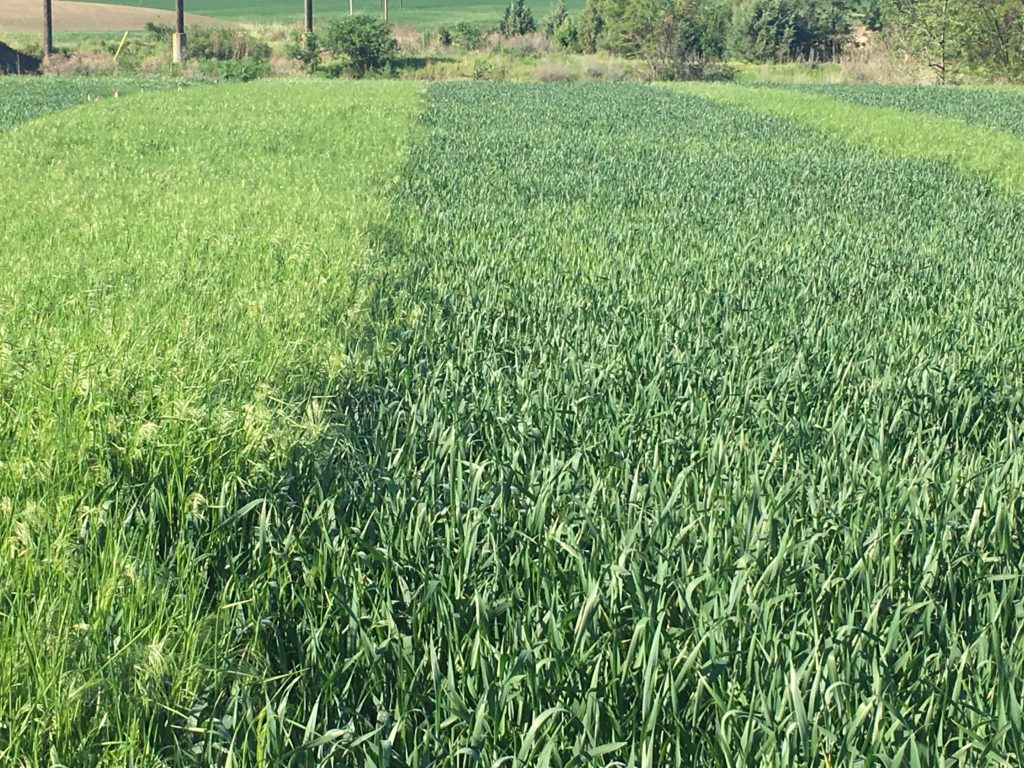Looking back to 2001, Clearfield wheat production system was released by BASF, using the herbicide, Beyond, to control rye and grasses in grain production. AGRI-TIMES NW remembers attending a Umatilla County field day when growers asked Dr. Jim Peterson, OSU wheat breeder, if he was going to use the favorable genetic traits to release a new variety. “I will develop new varieties using these traits if the Oregon growers want me to,” said Peterson. WSU had earlier indicated that they were NOT going to develop new varieties using the Clearfield traits. The rest became history, as up to 30% of the wheat acreage in the PNW was planted to Clearfield varieties. OSU varieties, ORCF 101 and ORCF 102, dominated the acreage in the early years until private breeders released newer varieties.
The background story for the new CoAxium grain production system started 10 years ago when Colorado wheat farmers, farming in a 35-40 bu region, wanted better grassy weed control. Growers identified a 30 year old herbicide that killed grasses. Wheat farmers said they wanted a wheat variety using those traits, at a modest cost, and requested that Colorado State University develop a patented trait.
Three major agricultural organizations came together in June 2015 to develop the revolutionary CoAXium method of producing wheat. Albaugh LLC, became the exclusive provider of the Aggressor herbicide for the CoAXium Wheat Production System around the globe; Limagrain became involved in the wheat genetics and provides donor lines to interested breeders; and Colorado Wheat Research Foundation is the owner of the patented Axigen trait.“The team work approach to releasing this variety allows for efficiency in bringing it into the market and provides great value to the agricultural industry,” said Chad Shelton, Director of Global Proprietary Products, Albaugh, LLC..
The four keys to the success of the CoAXium Wheat Production System according to Shelton are:
- Traits – Axigen patent
- Herbicide – Aggressor
- Germ Plasma- currently 10 wheat breeding partners in the trial.
- Stewardship – implementing technology and farming practices to extend the life of the trait.
“Most importantly, it is a production solution for wheat farmers requested by wheat farmers. Colorado farmers wanted better herbicide performance based on consistency. They wanted something with both performance and value. The Aggressor chemical cost will be a reasonable $12/acre. The value to the technology is that the growers own the trait,” said Shelton.” The program was launched at the grower level.”
Growers will be required to plant certified seed, assuring growers get the maximum performance from inputs and healthy crops. In addition, they will be required to adhere to the CoAXium Wheat Production System stewardship agreement outlining the best management practices on product rates, crop rotation and cultural practices.
A hard red wheat variety, Fusion AX, has been released for use in the PNW region. This variety was originally released with Colorado wheat growers in mind. It is an early maturing variety, with acceptable yields in areas receiving 12-16” rainfall. A soft white wheat variety will be released within 3-4 years. Looking at the big picture, there will be potential for 1,000,000 acres of wheat to be planted with the herbicide tolerance trait, AXigen, in the PNW market in the coming years.
Shelton has CoAXium trials underway in eight states. Its performance in controlling feral rye, downy brome, and goat grass has consistently been outstanding in the trials.
Some AGRI-TIMES NW readers have viewed the local test plots and seen that the herbicide totally kills cheatgrass and rye. No grasses were left standing– total annihilation! Growers are fighting Group 2, herbicide resistant, downy brome grass throughout the PNW. Even feral rye plants will germinate after Beyond application. It is easy to envision that within 5 years, the majority of farmers will switch from the Clearfield program to the CoAXium wheat production system to manage grassy weeds.
AGRI-TIMES NW wants to thank Chad Shelton for sharing insight on this important, new, wheat production system.Aggressor™ herbicide feral rye control study conducted by Montana State University in Bozeman, Montana.
Picture shows the high pressure of feral rye in the untreated plot on the left and a spring treatment with Aggressor herbicide at 10 oz/acre providing excellent control on the right. This plot yielded 98.3 bushels/acre which is 44.1 more bushels/acre than the untreated check which yielded 54.2 bushels/acre.
